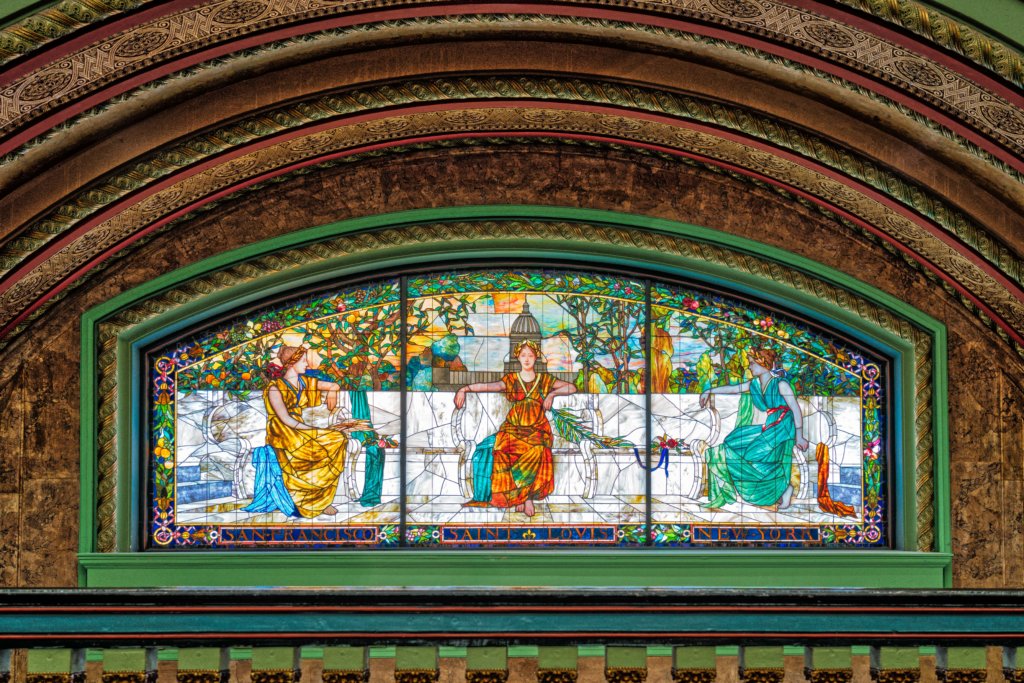
At one time, St. Louis was home to the grandest rail station in the country. Within its first decade of operation, right at the turn of the 20th century, an ordinary day might have seen more than 100,000 people pass through the great hall; presidents, world-famous baseball players, and people from all over the country walking under the vaulted ceiling and a two-ton wrought iron chandelier illuminated by more than 350 bulbs. They would hustle or meander over the terrazzo floor, and past the green-glazed bricks, gold-leaf detailing, intricate wooden carpentry, and elaborate plaster work to the platform where their train would be waiting.[1]
You can still find most of it there today, restored and returned to its original grandeur after a few years of loneliness. Among the most stunning elements that visitors of yesteryear saw and which visitors of today may still be pleased to encounter is the window on the north-facing wall of the Great Hall. Well, not so much a mere “window,” but a masterpiece of stained-glass art.
The Allegorical Window, as the piece is known, depicts three women, like the goddesses of Greek antiquity, sitting on a marble bench, with the imposing dome of a capitol building in the background and surrounded by thickets of fruit trees. As the labels in glass indicate, they each represent one of the three major cities for those traveling by train across the United States in 1984.[2]
Each of the women on either side of the image seats facing the woman in the middle, “Saint Louis” who ignores their stares and instead looks forward at the viewer beyond the image with confidence. The woman on the left, “San Francisco”, sits in her golden yellow gown facing Saint Louis with a neutral expression on her face, while the woman on the right, “New York”, stares with a seemingly less friendly expression, her emerald gown a reminder of the iconic Statue of Liberty.

Union Station St. Louis, photo by Mobilus In Mobili
The Allegorical Window was designed by the station’s architect, Theodore C. Link, in the early 1890s and was crafted by a local firm called Davis and Chambers using Tiffany Glass.[3]
Tiffany Glass is named after Louis Comfort Tiffany, the first design director at the jewelry company that would grow into one of the globe’s most recognizable brands. In 1878, his studio created a style of stained glass with new methods to produce colors and effects not seen before: glass that appeared to ripple or glow; glass that folded and bulged; glass with colors that blended and were run through by dark veins and fissures.
Today, antique Tiffany Studio table lamps, one of the more popular products at the time, may sell for over $45,000.[4] Numerous priceless works that were painstakingly cut and assembled by artisans from all over the country still adorn churches, universities, and other landmarks.
As other modes of transit overtook rail into the 1960s, the 11 acres of infrastructure at Union Station slowly fell out of use. By 1970, there were only about six trains arriving and departing daily.[5] The last train pulled out of the station in 1978. But remarkably, the piece remained for decades unbroken and untouched.
As the grand hall underwent its $135 million restoration in the 1980s, architect Tim Samuelson and designer Louis J. Millet entrusted the restoration of the hall’s showpiece to Conrad Schmitt Studios Inc.
The old-line firm reportedly used 30,000 pieces of scaffolding and had four craftsmen spend two years on the project.[6]
Union Station and the Allegorical Window have been preserved not just as an homage to its past glory, but as a gift of great cultural significance to the future St. Louis, a masterpiece with still so much to witness. At the Allegorical Window, the maidens still sit on either side of Saint Louis, with the undeniable recognition of her enduring presence in the American Middle.
References
[1] https://www.stlouisunionstation.com/story
[2] https://www.stlouisunionstation.com/story
[3] https://catalog.archives.gov/OpaAPI/media/63820903/content/electronic-records/rg-079/NPS_MO/70000888.pdf
[4] https://www.macklowegallery.com/collections/tiffany-lamps
[5] https://catalog.archives.gov/OpaAPI/media/63820903/content/electronic-records/rg-079/NPS_MO/70000888.pdf
[6] https://www.chicagotribune.com/news/ct-xpm-1985-09-15-8503020407-story.html